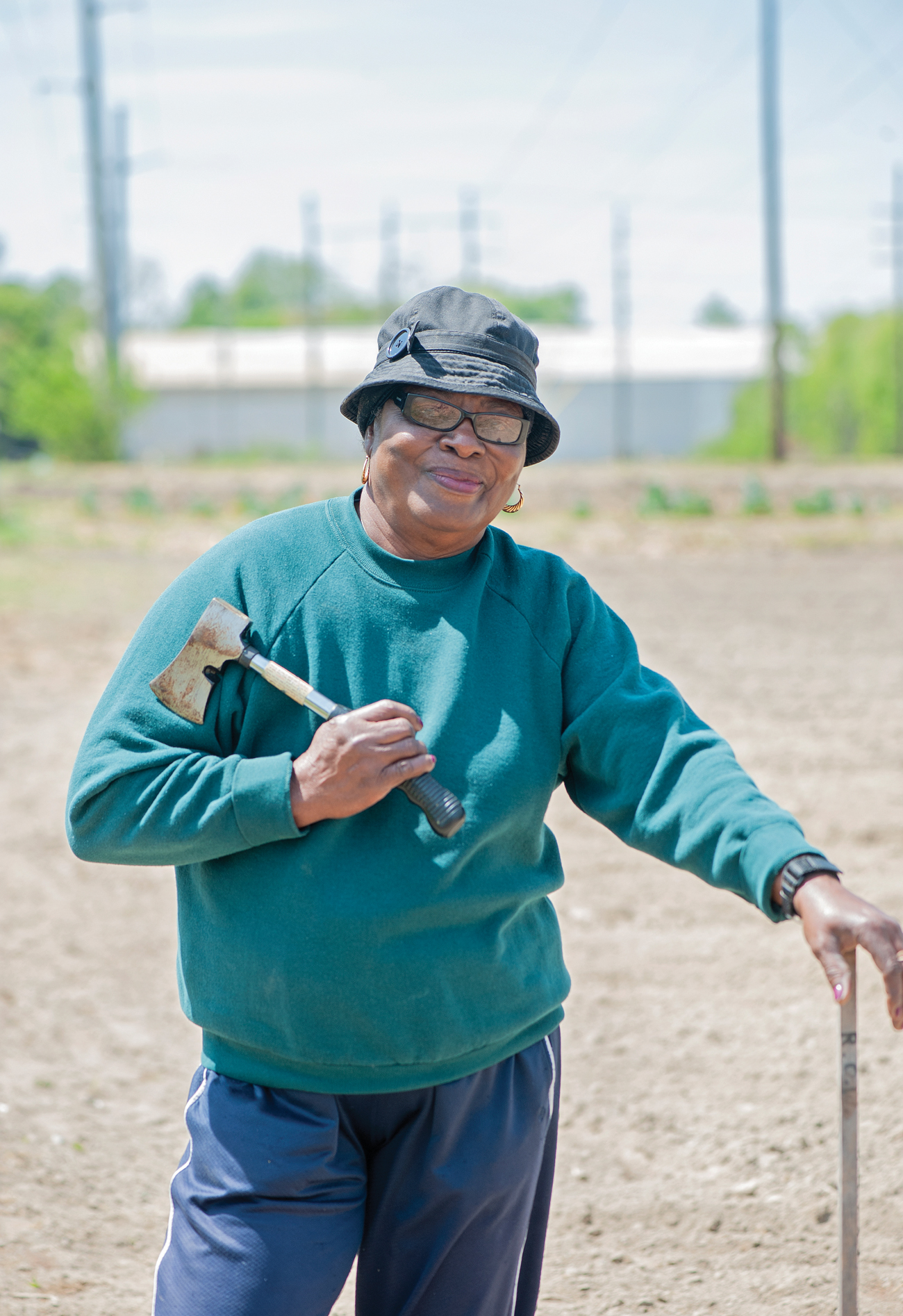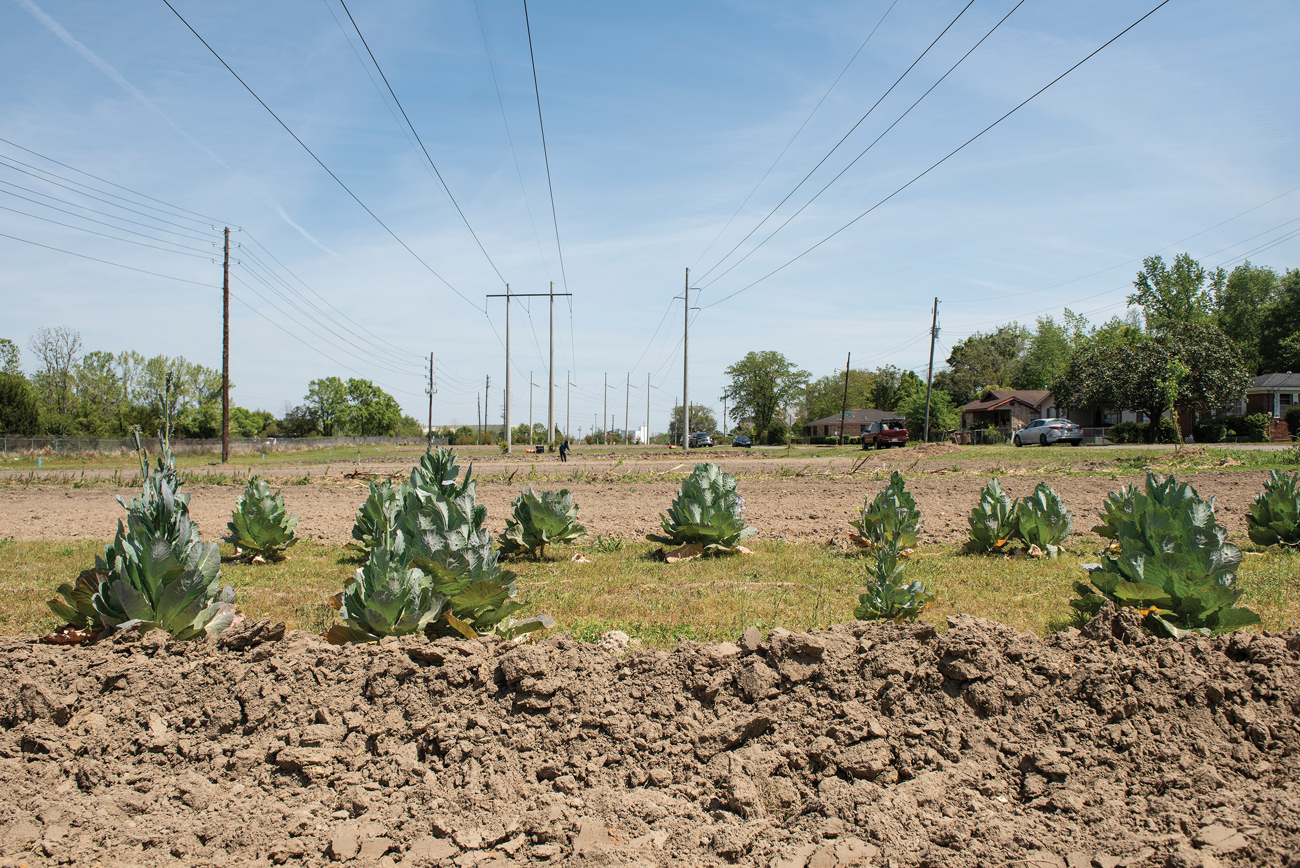
Mary Shaw rests one hand on her hip as she gazes out over the land. A breeze rushes past her, sending small puffs of newly tilled earth across Jakes Lane. As she hunches over the weathered handle of her hoe, beads of sweat glisten on her brow, an indication that Alabama’s heat has arrived early.
Mary’s been tending this strip of land in the Africatown Community Garden for four years now, and today is planting day. Mounded at the end of her plat lies the beginnings of what will soon be sweet potatoes, tomatoes, peppers, okra, corn and cantaloupe. “I just like to do gardening,” she says, not looking up. “I like to grow it, and I like to eat it. And I like helping people.”
Much like the 11 other men and women who farm alongside her, the fruit of Mary’s labor results in surplus, with overabundant produce given to friends, family and neighbors in need. But come summer, the breadth of people being assisted by the community gardeners’ toil will be larger than ever.

Digging into History
Africatown was formed by freed slaves, many of whom were brought over illegally on the infamous Clotilda. The group banded together to develop their own community and retain their customs and language. In 1880, the first black training school in Alabama — and the second oldest public school in the state — was formed, and Mobile County Training School still exists as a middle school.
Early community life entailed learning to read, write and speak English. Women raised and sold crops, and men worked in mills. Over time, the settlers were able to earn enough money to purchase the land on which they lived, and Africatown slowly grew into five distinct neighborhoods: Plateau, Magazine Point, Kelly Hills, Happy Hills and Lewis Quarters.
The self-governing society survived as a distinct community into the 1950s, when it was absorbed by Mobile. As major industries crept in, the population grew and local businesses sprouted. “We used to have stores all along the streets,” says lifelong resident Thelma Maiben-Owens. “There was Louise’s Luncheonette, Craig’s Drive-In, grocery stores, pharmacies and Amoco — we had two of ‘em.” The population peaked around 12,000 in 1960.
That number declined rapidly when paper mills closed, negatively affecting the viability of small businesses. Shops closed up, resulting in a lack of food providers for the 1,800 or so remaining residents. This led to Africatown’s designation as a food desert, which, according to the U.S. Department of Agriculture, is an area devoid of fresh fruit, vegetables and other healthful whole foods.

Growing Hope
Despite the rise and fall of economic prospects, one aspect of the community prospered. “The garden has existed in one form or another for the past 50 years,” Thelma says as she motions along the 7 acres’ worth of tilled land bound between Jakes Lane, Paper Mill Road and Shell Bayou. She and Willie “Junebug” Jones are the two remaining original gardeners.
Much has happened over those five decades, with possibly the most exciting events occurring in the last few years as Africatown has experienced national recognition for its history and direct connection to the slave trade. As the broader community began to better appreciate the history of this area, they also saw the great need. In 2015, with support from the Alabama Department of Agriculture, Alabama Power officially deeded the garden plot to the Africatown Community Development Corporation. Shortly after, 16 new water faucets were installed. Prior to having access to running water, gardeners filled 5-gallon buckets at their homes, loaded it into their cars and delivered it to the garden.
As the garden increased its bounty, talk of a market to sell the fresh produce circulated. This past March, the community held a groundbreaking ceremony for a new marketplace, supported by a $50,000 grant from the Alabama Department of Economic and Community Affairs’ Healthy Food Financing Program.
The open-air market site, shaded by a gnarled oak tree and freshly planted crepe myrtles, will boast local vendors selling fresh produce — not the least of which will be offerings from the Africatown Community Garden — four days a week. The site will also be home to a neighborhood store, open six days a week, selling grocery essentials like milk and bread.
Customer traffic is expected to be high. Located in the almost-triangular space between Paper Mill Road, Tin Top Lane and Shelby Street, the marketplace is centrally located to all five neighborhoods and is visible to Cochrane-Africatown Bridge commuters.
And in what could be seen as a turning of tides, the Meaher family, whose ancestor funded the Clotilda’s fateful voyage, owns Chippewa Lakes, the company responsible for donating the marketplace land.

Cultivating Tomorrow
Heard amongst small, tidy houses, weathered tombstones and the greenest cabbage collards is the quiet tinny of settlers, those whose dream it was to create a safe, supportive and cohesive town. A $3-million Welcome and Heritage Center, to be developed over the next several years, will soon give them voice. And while Africatown has more history, successes and struggles than there is space to share here, the future of this community is, quite literally, ripe with hope.





